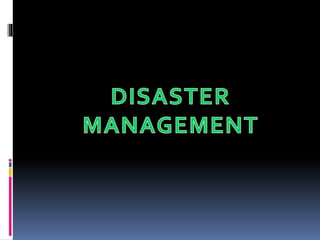
Disaster management
- 3. DISASTER MANAGEMENT Disaster management) is the discipline of dealing with and avoiding risks. It is a discipline that involves preparing for disaster before it occurs, disaster response (e.g. emergency evacuation, quarantine, mass decontamination, etc.), as well as supporting, and rebuilding society after natural or human-made disasters have occurred. In general, any Emergency management is the continuous process by which all individuals, groups, and communities manage hazards in an effort to avoid or ameliorate the impact of disasters resulting from the hazards. Actions taken depend in part on perceptions of risk of those exposed. Effective emergency management relies on thorough integration of emergency plans at all levels of government and non-government involvement. Activities at each level (individual, group, community) affect the other levels. It is common to place the responsibility for governmental emergency management with the institutions for civil defense or within the conventional structure of the emergency services. In the private sector, emergency management is sometimes referred to as business continuity planning.
- 5. Disaster Management is one of a number of terms which, since the end of the ColdWar, have largely replaced Civil defense, whose original focus was protecting civilians from military attack. Modern thinking focuses on a more general intent to protect the civilian population in times of peace as well as in times of war. Another current term, Civil Protection is widely used within the European Union and refers to government-approved systems and resources whose task is to protect the civilian population, primarily in the event of natural and human-made disasters. Within EU countries the term Crisis Management emphasizes the political and security dimension rather than measures to satisfy the immediate needs of the civilian population. An academic trend is towards using the term disaster risk reduction, particularly for emergency management in a development management context.This focuses on the mitigation and preparedness aspects of the emergency cycle (see below).
- 7. Phases and professional activities The nature of management depends on local economic and social conditions. Some disaster relief experts such as Fred Cluny have noted that in a sense the only real disasters are economic. Experts have long noted that the cycle of emergency management must include long- term work on infrastructure, public awareness, and even human justice issues. This is particularly important in developing nations. The process of emergency management involves four phases: mitigation, preparedness, response, and recovery.
- 10. Mitigation Mitigation efforts attempt to prevent hazards from developing into disasters altogether, or to reduce the effects of disasters when they occur. The mitigation phase differs from the other phases because it focuses on long-term measures for reducing or eliminating risk. The implementation of mitigation strategies can be considered a part of the recovery process some structural if applied after a disaster occurs.[mitigation measures may have adverse effects on the ecosystem.
- 12. Imitative measures can be structural or non- structural. Structural measures use technological solutions, like flood levees. Non-structural measures include legislation, land-use planning (e.g. the designation of nonessential land like parks to be used as flood zones), and insurance. Mitigation is the most cost-efficient method for reducing the impact of hazards, however it is not always suitable. Mitigation does include providing regulations regarding evacuation, sanctions against those who refuse to obey the regulations (such as mandatory evacuations), and communication of potential risks to the public
- 14. Preparedness In the preparedness phase, emergency managers develop plans of action for when the disaster strikes. Common preparedness measures include: communication plans with easily understandable terminology and methods. proper maintenance and training of emergency services, including mass human resources such as community emergency response teams. development and exercise of emergency population warning methods combined with emergency shelters and evacuation plans. stockpiling, inventory, and maintain disaster supplies and equipment.
- 16. Response The response phase includes the mobilization of the necessary emergency services and first responders in the disaster area. This is likely to include a first wave of core emergency services, such as firefighters, police and ambulance crews. When conducted as a military operation, it is termed Disaster Relief Operation (DRO) and can be a follow-up to a Non-combatant evacuation operation (NEO). They may be supported by a number of secondary emergency services, such as specialist rescue teams. A well rehearsed emergency plan developed as part of the preparedness phase enables efficient coordination of rescue Where required, search and rescue efforts commence at an early stage. Depending on injuries sustained by the victim, outside temperature, and victim access to air and water, the vast majority of those affected by a disaster will die within 72 hours after impact.
- 18. Recovery The aim of the recovery phase is to restore the affected area to its previous state. It differs from the response phase in its focus; recovery efforts are concerned with issues and decisions that must be made after immediate needs are addressed. Recovery efforts are primarily concerned with actions that involve rebuilding destroyed property, re- employment, and the repair of other essential infrastructure. An important aspect of effective recovery efforts is taking advantage of a ‘window of opportunity’ for the implementation of mitigative measures that might otherwise be unpopular. Citizens of the affected area are more likely to accept more mitigative changes when a recent disaster is in fresh memory.
- 20. Disaster management in INDIA In India, the role of emergency management falls to National Disaster Management of India, a government agency subordinate to the Ministry of Home affairs. In recent years there has been a shift in emphasis, from response and recovery to strategic risk management and reduction, and from a government-centred approach to decentralized community participation.Survey of India, an agency within the Ministry of Science andTechnology, is also playing a role in this field, through bringing the academic knowledge and research expertise of earth scientists to the emergency management process.